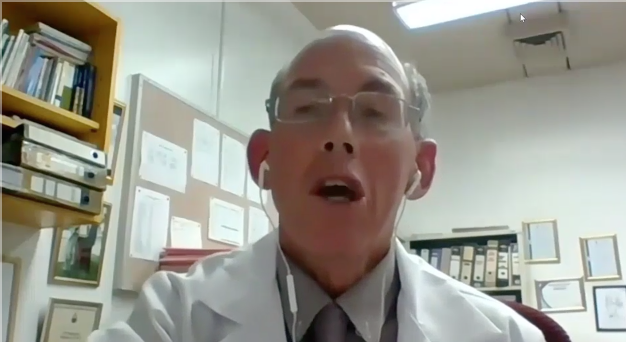 Dr Frederick Raal
Dr Frederick RaalEvinacumab, a fully human monoclonal antibody inhibitor of ANGPTL3, effectively lowers LDL-cholesterol (LDL-C) levels in patients with homozygous familial hypercholesterolaemia (HoFH) regardless of their LDL receptor (LDLR) function, according to results of a double-blind phase III trial presented at the American College of Cardiology and World Congress of Cardiology virtual meeting (ACC.20/WCC).
In the study, 65 patients with HoFH (diagnosed by genotyping or clinical criteria), who were ≥12 years of age with LDL-C ≥70 m/dL despite stable maximally tolerated lipid-lowering therapy (LLT) with or without apheresis at screening, were randomized (2:1) to receive evinacumab (15 mg/kg intravenously [IV] Q4W) or placebo (IV Q4W) for 24 weeks. [Raal F, et al, ACC.20/WCC, abstract 411-12]
The primary endpoint of percent change in LDL-C from baseline at 24 weeks was -47.1 percent in the evinacumab group, compared with +1.9 percent in the placebo group (difference, -49.0 percent; p<0.0001).
“Evinacumab therapy resulted in a rapid lowering of LDL-C that was seen at 2 weeks and maintained through 24 weeks,” said investigator Dr Frederick Raal of the University of the Witwatersrand, Johannesburg, South Africa.
“At 24 weeks, the absolute change in LDL-C was -134.7 mg/dL in the evinacumab group, which is remarkable,” said Raal. “In the placebo group, the corresponding absolute change was -2.6 mg/dL, with a between-group difference of -132.1 mg/dL [p<0.0001].”
In the evinacumab group, 83.7 percent and 55.8 percent of patients achieved ≥30 percent and ≥50 percent reduction in LDL-C, respectively, compared with 18.2 percent (odds ratio [OR], 25.2; 95 percent confidence interval [CI], 5.7 to 110.5; p<0.0001) and 4.5 percent (OR, 24.2; 95 percent CI, 3.0 to 195.6; p=0.003) of patients in the placebo group.
“Remarkably, 46.5 percent of evinacumab-treated patients achieved LDL-C <100 mg/dL [vs 22.7 percent in the placebo group; OR, 5.7; 95 percent CI, 1.3 to 24.9; p=0.02],” highlighted Raal.
Significant reductions from baseline were also seen with evinacumab in apolipoprotein B (apoB; 36.9 percent), non-HDL-cholesterol (51.7 percent), total cholesterol (48.4 percent) and triglycerides (50.4 percent) (all p<0.0001), but not in lipoprotein(a) (1.9 percent; p=0.7906).
“The efficacy of evinacumab in LDL-C lowering was similar between patients with null/null and non-null/null LDLR genotype,” Raal noted.
At study baseline, patients’ mean age was 44.3 years in the evinacumab group and 36.7 years in the placebo group (55.8 percent and 50 percent female, respectively). A history of coronary heart disease was present in 88.4 percent and 95.5 percent of the patients, respectively, while non-null/null LDLR genotype was identified in 65.1 percent and 72.7 percent of the patients.
Of note, 69.8 percent vs 50 percent of the patients were on ≥3 LLTs at baseline. The most commonly used LLT was statin (95.3 percent vs 90.9 percent), followed by PCSK9 inhibitor (79.1 percent vs 72.7 percent) and ezetimibe (76.7 percent vs 72.7 percent). Apheresis was used by 32.6 percent vs 36.4 percent of the patients.
Despite the intensive LLT, the patients’ mean LDL-C at baseline was 259.5 mg/dL and 246.6 mg/dL, respectively, while their mean apoB level was 169.1 mg/dL and 175.9 mg/dL, respectively.
“Evinacumab was generally well tolerated. Rates of treatment-emergent adverse events [TEAEs] were similar between the two groups [65.9 percent vs 81 percent],” said Raal.
The most common TEAEs in the evinacumab group were nasopharyngitis (15.9 percent vs 23.8 percent in the placebo group) and influenza-like illness (11.4 percent vs 0 percent).
In the evinacumab group, one patient had urosepsis and another had suicide attempt, but none of these were considered to be related to the study drug, Raal noted.
“These results suggest that evinacumab may provide an effective treatment option for patients with FoFH who are unable to reach target LDL-C despite multiple conventional LLTs with or without apheresis,” he concluded.
The study’s limitations included the relatively short duration. The longer-term safety of evinacumab is being further evaluated in the ongoing open-label phase of the trial, in which all patients receive evinacumab therapy for another 24 weeks.